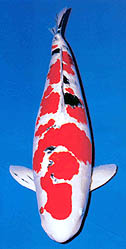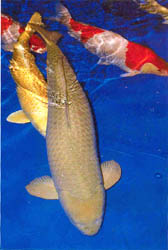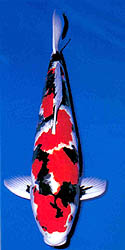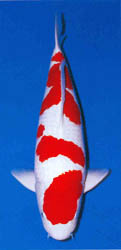"The Greatest Show on Earth" During the third week of January, thousands of Koi dealers from all around the world make their annual pilgrimage to the Mecca of Koi keeping, the All Japan Combined Koi Show in Tokyo. Over 3,400 of the world's finest Nishikigoi are gathered here under one roof, for what is undisputedly, "The Greatest Show on Earth." For the hobbyist, the All Japan Show provides an arena in which they can compare their Koi against the stiffest possible competition, or simply a catalogue of excellence with each Kohaku more radiant than the last. For the breeder, the show is a place where he can compare his creations to those of his competitors. On Thursday, when Koi were being entered into the show, I asked Mr. Takashi Omosako, Japan's most respected Shiro Utsuri breeder, what he thought of the competition this year? Ever the diplomat, he replied, "We spent the entire year in the countryside, in Hiroshima, working to produce the finest Shiro Utsuri possible. By the time we harvest our Koi in the fall, our spirits are high and our confidence rises. Coming here makes me acutely aware that there is a world full of other breeders outside of Hiroshima with exactly the same aspirations..it would be different if we were the only one." For the dealer, like myself, the show provides an opportunity to visit with the breeders, inquiring about last season's successes, and contracting livestock for the upcoming season. It also gives us a chance to exchange information with dealers from all over the wold regarding trends, health concerns, and miscellaneous shoptalk. For the past several years, I have had the privilege of being appointed to the position of official translator for the All Japan Show, partly because of my command of the Japanese language, but mostly because I am willing to work for nothing. In all seriousness, this position has given me a front row seat and an insider's view to the judging procedure, which is an education that I wouldn't trade for the world. On Friday, the Exhibition Hall is closed to the public until the task of judging the entries is completed. Judging a show of this magnitude is quite an undertaking, requiring one full day, 79 Judges, a team of 6 observers, and over 150 fish handlers and office staff. The Judges are separated into 14 teams consisting of five to six members, and each team is assigned to judge several size classes of Koi. The only part of judging that differentiates greatly from our Koi shows here in the United States is that the Grand Champion is chosen as the first order of business, before any of the other Koi are judged. This is accomplished by written ballot, with each of the 79 Judges casting a vote and a majority count of 40 or more votes required to determine the outcome. In past years, selecting the Grand Champion has required that several votes be taken before a clear winner has been established. With so many stunning Koi to choose from and so many judges involved, it is rare indeed that one contender stands out clearly from all the rest. As the first round of ballots was counted, it became obvious that this year was going to be special. With a total of 51 out of 79 votes, Mr. Matsumoto's Taisho Sanshoku was declared Grand Champion of the 31st All Japan Combined Koi Show. Those of you who have read my Tategoi series know that I delight in debunking Koi myths and misinformation regarding the hobby. The selection of this Koi as Grand Champion presents me with two opportunities that I simply cannot resist. How often have we heard the comment that a red eye is an unacceptable feature in a Kohaku or Sanke of show quality? This sentiment is obviously not shared by the world's leading breeders who judged this Sanke. We have all heard the "advanced" hobbyist comment "I won't consider owning any males, as everyone knows that males can't compete in the larger size categories for major awards." Evidently this school of thought is not shared by this year's Grand Champion, an 88 cm (34.5") male that dominated the competition of mostly female Koi. That's right, folks, an 88 cm male Grand Champion with a red eye! After the selection of Grand Champion, my duties as translator kept me in close contact with Team 12 translating for the Judge from Germany, Josef Bergen. Team 12 was led by Toshio Sakai, of Matsunosuke fame, and included both Seiji Hiroi and Chogoro, all world-renowned breeders. Spending the day with breeders of this stature proved to be another priceless experience, providing insights and perspectives that simply are not available to most of us who reside outside of Japan. One such insight came when the team was discussing which Koi to choose for 1st place Kawarigoi 90 Bu. The competition had come down to two Chagoi. One was almost 40" long with a body confirmation that was textbook perfection. The other was 53", yes 53" long and weighed 115 pounds! One would think that there would be no contest, but the German Judge made the observation that the larger Koi, although truly impressive, had rather poor body confirmation. This prompted Chogoro, the world's most famous Platinum breeder, to ask me to translate for him. "It's true," he said, "that the larger Chagoi has a body confirmation that is somewhat less than ideal. It's important to note that some deterioration of body confirmation in older and especially larger Koi is to be expected. But I would like to emphasize that I have attended every single one of the past 30 All Japan Koi Shows, but never has there been a Koi of these immense proportions. I believe we have been presented with a historic moment." The vote was unanimous in favor of the 53" Chagoi, which incidentally also belongs to Mr. Matsumoto. The 31st All Japan Koi Show also marked the first time that the show had been closed to entries of Koi from outside of Japan, much to the disappointment of many who had planned to send their Koi to Japan for the Show. This precaution was taken in response to an outbreak of SVC that was identified in a shipment of Koi shipped from China to England. SVC is a virus that is deadly to Koi, but has not yet entered Japan. Because of the ban on entries from overseas, hobbyists from abroad were limited to entering Koi that had been kept in Japan. A number of American hobbyists did have Koi in Japan and had entered them in the Show. Dr. Gene Ewy was one such participant. He is also a member of the AKCA Judging Committee. Gene is a dedicated Koi keeper and this year had two Koi entered in the show. Gene had purchased both Koi a year prior to the show, but had left them in Japan, to see how they would develop under the care of Miyoshiike, a Koi dealer known for grooming champions. The larger of the two was a stunning Kohaku bred by Hoshikin of Niigata. With its bold pattern and deep red reflecting its Dainichi bloodline, this powerful make could easily have been mistaken of a female. The other Koi was a 4 year old male Showa Sanshoku bred by Sakai of Hiroshima, and it was a previous winner of the coveted Kokugyo award at the 1998 All Japan Show. Kokugyo translates as "Fish of the Nation" or "National Fish," and it is one of the highest honors a Koi can achieve. It is the equivalent of our "Best in Size" awards and you can well imagine what an honor it is to receive such an award in a show that has over 3,000 entrants. When all the judging was concluded, the names of the winners of the major awards were posed on placards above the show tanks. Never in the 30-year history of this show had an American hobbyist taken a major award, so when I saw the same placard, I rushed over to have a look. Lo and behold, I saw that the Kokugyo Make 70 Bu, Kohaku, and the Kokugyo Make 60 Bu, a Showa Sanshoku, both belonged to Gene Ewy! With several other American entries, and over one hundred U.S. and Canadian visitors to the show, we have definitely played our part in making the All Japan Show a truly international event. In recent years, travel to Japan has become quite affordable with a number of package tours that include even transportation to the show. If you haven't been able to do so in the past, or you plan to make that once-in-a-lifetime visit to Japan, make it a point to see "The Greatest Show on Earth."
BACK TO TOP |
|||||||||||||||
|
|
|||||||||||||||




